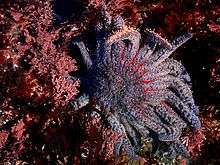Sunflower seastar
| Sunflower seastar | |
|---|---|
 | |
| Scientific classification | |
| Kingdom: | Animalia |
| Phylum: | Echinodermata |
| Class: | Asteroidea |
| Order: | Forcipulatida |
| Family: | Asteriidae |
| Genus: | Pycnopodia |
| Species: | P. helianthoides |
| Binomial name | |
| Pycnopodia helianthoides Brandt, 1835 [1] | |
Pycnopodia helianthoides, commonly known as the sunflower seastar, is a large sea star found in the northeast Pacific. It is among the largest sea stars in the world (but not quite the largest), with a maximum armspan of 1 m (3.3 ft). Sunflower seastars usually have 16 to 24 limbs; their color can vary widely. They are predatory, feeding mostly on sea urchins, clams, snails, and other small invertebrates.
Description
Sunflower seastars can grow to have an arm span of 1 m (3.3 ft) in diameter.[2] Their color ranges from bright orange, yellow and red to brown and sometimes to purple, with soft, velvet-textured bodies and 16 to 24 arms with powerful suckers.[2][3] Most sea star species have a mesh-like skeleton to protect their internal organs.[4]
Distribution and habitat
Sunflower seastars are common in the northeast Pacific from Alaska to Southern California,[2] and are largest in Puget Sound, British Columbia and Alaska.[4] They generally inhabit low subtidal and intertidal areas rich in seaweed[5] or kelp.[6] They do not venture into high- and mid-tide areas because their body structure is fleshy and requires water to support it.[7]
Diet
Sunflower seastars are quick, efficient hunters, moving at a speed of 1 m/min (3.3 ft/min) using 15,000 tube feet which lie on the undersides of their bodies.[2][3] They are commonly found around urchin barrens, as the sea urchin is a favorite food. They also eat clams, snails, abalone, sea cucumbers and other sea stars.[2] In Monterey Bay, California, they will feed on dead or dying squid.[8] Although the sunflower seastar can greatly extend its mouth, for larger prey, the stomach can extend outside the mouth to digest prey, such as gastropods like abalone.[9]
Easily stressed by predators such as large fish and other sea stars, they can shed arms to escape, which will grow back within a few weeks. They are preyed upon by the king crab.[4]

Reproduction
Sunflower seastars can reproduce either asexually through fissiparity or sexually through broadcast spawning.[10] They also have separate sexes.[9] Sunflower seastars breed from May through June. In preparing to spawn, they arch up using a dozen or so arms to hoist their fleshy central mass free of the seafloor and release gametes into the water for external fertilization.[9] The microscopic sea star larvae float and feed near the surface for 2 to 10 weeks. After the planktonic larval period, the larvae settle to the bottom and transform into juveniles.[4] Juvenile sunflower seastars begin life with five arms, and grow the rest as they mature.[8] The lifespans of most sunflower seastars is three to five years.
References
- ↑ "Pycnopodia helianthoides". Integrated Taxonomic Information System. Retrieved 9 April 2007.
- 1 2 3 4 5 Sunflower seastar - NOAA
- 1 2 Telnack, Jennifer. Intertidal Marine Invertebrates of the South Puget Sound, NW Marine Life.
- 1 2 3 4 Sunflowerstar. Scott Boyd's Emerald Sea Photography.
- ↑ North Coast Intertidal Guide: Seastars & Urchins, Humboldt State University. Arcata, CA.
- ↑ Sunflower Star. Channel Islands National Park. National Park Service.
- ↑ Sunflower Star. North Island Explorer.
- 1 2 Monterey Bay Aquarium: Online Field Guide - Sunflower star. Monterey Bay Aquarium.
- 1 2 3 Sea stars and relatives, Edmonds Discovery Programs, City of Edmonds, Washington.
- ↑ Aaron Shepard. "Pycnopodia helianthoides, The Sunflower Star". Evergreen State College. Retrieved 28 February 2012.
External links
| Wikimedia Commons has media related to Pycnopodia helianthoides. |